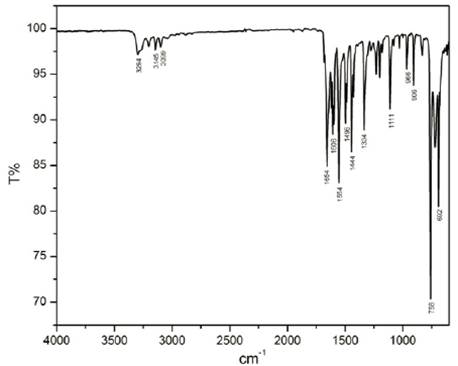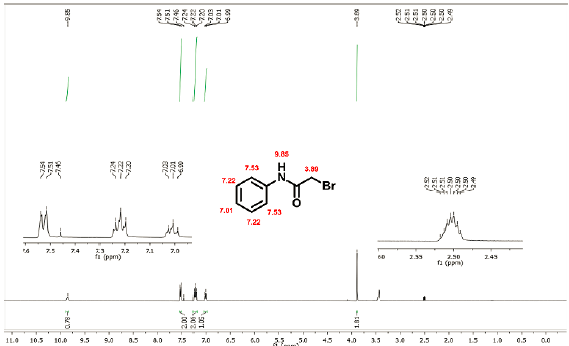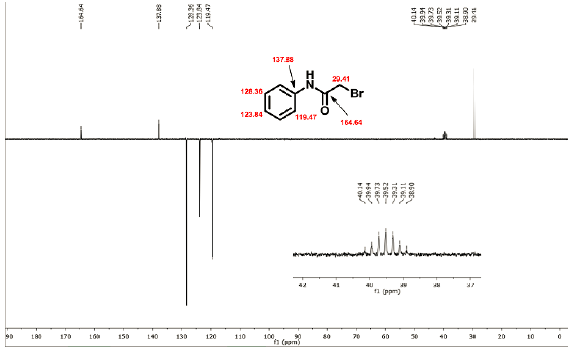INTRODUCTION
Invasive candidiasis is the most frequent invasive fungal infection. Despite advances in the care of critically ill patients, invasive candidiasis still promotes prolonged hospitalization, with a gross mortality rate of around 50 %, which signals the need to improve clinical practices, including early diagnosis and accurate antimycotic pharmacotherapy [1]. The main causative agent of invasive candidiasis is Candida albicans, but with the advancement of molecular biology techniques of identification an increase in the number of detections of non-albicans species has been observed, and this is associated with reduced antifungal susceptibility and outbreaks [2].
The pharmacotherapy available for the systemic treatment of Candida infections includes triazole agents (fluconazole, itraconazole, voriconazole, posaconazole, isavuconazole, ravuconazole and albaconazole), echinocandins (caspofungin, micafungin and conventional anidulafungin and antidotefine) and flucytosine. Although first-line drugs (triazole agents and echinocandins) are effective, some species of Candida are naturally resistant to them. In addition, there is a growing index of strains resistant to multiple drugs [3].
Due to the limitations of conventional antifungals and the resistance presented by Candida species, the search for new pharmacotherapeutic alternatives is increasingly necessary. The research of synthetic drugs has grown considerably in the last few years due to the agility in the processing and the capacity of molecular modeling, becoming a tool of great importance for the development of drugs with safer and more efficient properties [4].
The synthetic compound 2-bromo-N-phenylacetamide, with C8H8BrNO molecular formula, is obtained from an acetylation reaction between aniline and bromoacetyl bromide. This substance is commonly used in chemical sciences as an intermediary for chemical reactions [5], however, its antimicrobial activity is not yet described in the literature, which provides a potential source for investigation.
Given this context, this study aimed to evaluate the antifungal activity of 2-Bromo-N-phenylacetamide against invasive candidiasis isolates, by determining the minimum inhibitory and fungicide concentrations. In addition, molecular docking was performed, to investigate the possible mechanism of action of the substance. The substance was also associated with fluconazole, to assess the viability of the combination in clinical practice.
EXPERIMENTAL
Chemistry
All reagents and solvents were purchased from commercial sources (Sigma-Aldrich, São Paulo, Brazil). NMR spectroscopic data were recorded with a Bruker Avance 400 instrument. 1H NMR spectroscopic data were recorded in DMSO at 500 MHz using the residual non-deuterated solvent as an internal standard (δ H 2.50 ppm). 13C NMR spectra were recorded in DMSO at 126 MHz using the deuterated solvent as an inter nal standard (δ C 39.52 ppm), and tetramethylsilane (TMS) was used for the internal standard. Chemical shifts (δ) were measured in parts per million (ppm), and the coupling constants (J) in hertz (Hz). The spectra (IR) were obtained on a Shimadzu model IRPrestige-21 FTIR spectrometer, with an attenuated total reflection (ATR) accessory. The purification of the compound was performed by recrystallization in ethanol/water and confirmed by determining the melting range on an MQAPF-302 hotplate (microquímica).
Preparation of 2-Bromo-N-phenylacetamide (A1Br) [5]
In a 50 mL flask containing aniline (1.86 g, 0.020 mol) and K2CO3 (3.31 g, 0.024 mol) solubilized in 20 mL of CHCl3 at a temperature of 0 °C, 2-bromoacetyl bromide (4.84 g, 0,024 mol) is slowly added. The ice bath was then removed, and the reaction stayed under agitation for 20 h at room temperature. The reaction mixture was monitored by TLC (hexane/methyl acetate 1:1). At the end of the reaction, the reaction mixture was filtered, and the solvent was evaporated under reduced pressure, yielding a precipi tate. The solid was obtained by the recrystallization method using ethanol/water (8:2). Yield: 80 % M.P. 130-132 °C (Lit.: [6] 129-131°).
IR (cm -1 , ATR): 3294 (NH), 3145, 3099 (CHAr.), 1654 (C = O), 1606 (N-H), 1554, 1496 (C=CAr.), 1444 (CH2), 1111 (C - Br), 758 (CHAr).
1 H NMR (400 MHz, DMSO-d 6 ): δ 9.85 (s, 1H, N-H), 7.53 (d, J = 8.7 Hz, 2H, Ar-H), 7.22 (t, J = 8.0 Hz, 2H, Ar-H), 7.01 (t, J = 7.4 Hz, 1H, Ar-H), 3.89 (s, 2H, CH2).
13 C NMR (101 MHz, DMSO-d 6 ): δ 164.64, 137.88, 128.36, 123.84, 119.47, 29.41.
Antimicrobial activity
Microorganisms
The present study was approved by the Research Ethics Committee of the Health Sci ences Center of the Federal University of Paraíba, under the number 3.715.836. Ten clinical isolates of C. albicans (117, 516, 587, 616, 699, 700, 800, 807, 814 and 917) and five isolates of the C. parapsilosis complex (439, 546, 689, 5770 and 55117) were used, which came from patients with invasive candidiasis assisted at Hospital Universitário Lauro Wanderley (João Pessoa, Brazil). The identification and characterization of the sensitivity profile against antifungals was carried out using the Candifast kit (International Microbio), complemented by microscopic and biochemical techniques. As controls, C. albicans ATCC 76485 and C. parapsilosis ATCC 22019 were used. Candida cultures were grown on sabouraud dextrose agar and incubated at 35 ± 2 °C for 24-48 h. After this period, colonies were suspended in sterile saline (0.85 %) and the turbidity was adjusted to obtain the final inoculum concentration with 106 CFU mL-1 [7,8].
Determination of the Minimum Inhibitory Concentration (MIC)
The MIC determination was performed based on the standard recommendations [9], using the broth microdilution technique in a 96-well plate to obtain different concentrations of A1Br.
Initially, 100 μL of double strength RPMI-1640 broth (Sigma-Aldrich/ Merck") was added to the wells, and 100 μL of the test product was subsequently added. Serial microdilutions were performed in which a 100 μL aliquot from a well containing more concentrated medium was transferred to the next well with less concentrated medium, producing final A1Br concentrations ranging from 2048 to 0.5 μg/mL. Finally, 10 μL of Candida spp. inoculum was added to the wells such that each column contained a different strain. At the same time, the sterility controls of the culture medium, viability of the strains and interference of the vehicles used in the preparation of A1Br emulsions (DMSO and Tween-80) were also performed. MIC is defined as the lowest concentration capable of causing complete inhibition of yeasts growth after 24-48 h at 35 ± 2 °C.
Determination of the minimum fungicide concentration (MFC)
After MIC reading, MFC was determined by removing aliquots from the microdilution plates in the wells corresponding to concentrations equivalent to MIC, 2 x MIC, 4 x MIC and 8 x MIC and inoculating in new plates containing only culture broth. All controls were performed in parallel. MFC is defined as the lowest con centration capable of causing complete inhibition of yeasts after 24-48 h at 35 ± 2 °C. Thus, it is possible to determine whether the substance acts as a fungicidal or fungistatic agent [10].
Molecular docking
The Molegro Virtual Docker (MVD) software [11] (v 6.0.1, Molegro ApS, Aarhus, Denmark) was used to analyze the interactions of A1Br with membrane and cell wall enzymes of Candida spp. The crystallographic structure of exo-β-(1,3)-glucanase (cell wall) and 14-α-demethylase (cell membrane) were acquired from Protein Data Bank [12] under the codes 1EQC (1.85 Å) and 5TZ11 (2 Å), respectively. The water mole-cules were removed from the enzyme structure.
Checkerboard assay
To check the effect of the association of A1Br with fluconazole, the checkerboard method was performed. Thus, different concentrations of A1Br (8 x MIC, 4 x MIC, 2 x MIC, MIC, 1/2 MIC, 1/4 MIC and 1/8 MIC) were combined with different con centrations of fluconazole (8 x MIC, 4 x MIC, 2 x MIC, MIC, 1/2 MIC, 1/4 MIC and 1/8 MIC) and then fungal inoculum was added. All controls were performed in parallel. The reading of the experiment was done after incubation at 35 ± 2 °C for 24-48 h to observe the presence or not of the visible yeasts growth.
The effect produced between the combinations was determined by the fractional inhi bitory concentration index (FICI). This index was calculated by the sum of fractional inhibitory concentrations (FIC), where FICA = (MIC of substance A in combination)/(MIC of substance A alone) and FICB = (MIC of substance B in combination)/ (MIC of substance B alone), thus FICI = FICA + FICB. The association was defined as synergistic for FICI ≤ 0.5, as additive for 0.5 < FICI <1, as indifferent for 1 ≤ FICI < 4, and as antagonistic for FICI ≥ 4 [13].
RESULTS AND DISCUSSION
Chemistry
The synthesis of 2-Bromo-N-phenylacetamide (A1Br) was performed in a single synthetic step, using the procedures described by Kaushik et al. [ 5] and the representation of the synthetic is described in scheme 1.
2-Bromo-N-phenylacetamide was prepared from the acetylation reaction using aniline and bromoacetyl bromide as the acylating agent in the presence of potassium carbo nate as the base and in chloroform as a solvent at room temperature for 20 h. The structure of A1Br was confirmed using infrared (IR) (figure 1) and 1H (figure 2) and 13C (figure 3) nuclear magnetic resonance (NMR) spectroscopy techniques.
Antimicrobial study
Ali strains analyzed were sensitive to the antifungal agents, amphotericin B, nystatin, flucytosine, ketoconazole and miconazole. However, it was identified that 41.2 % of the strains were resistant to fluconazole. Regarding the sensitivity to 2-Bromo-N-phenylacetamide, the results are shown in table 1.
Table 1 Minimum inhibitory and fungicide concentrations (MIC and MFC) of 2-Bromo-N-phenylacetamide against invasive candidiasis isolates.
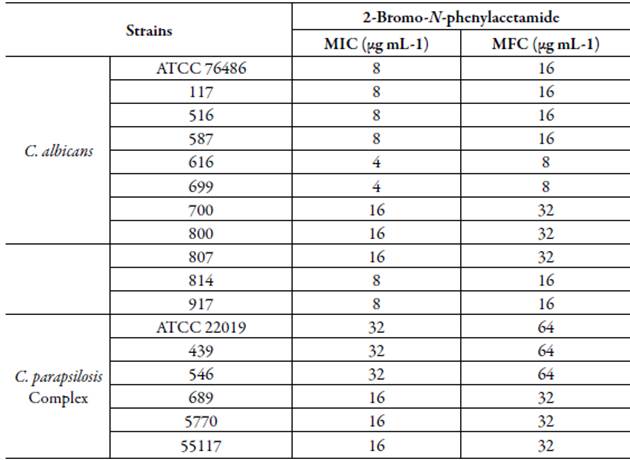
The MIC of 2-bromo-N-phenylacetarnide ranged from 4 to 16 μg mL-1 for C. albi cans and between 16 to 32 μg mL-1 for the C. parapsilosis complex. Thus, it is observed that all strains used in this study were susceptible to the action of A1Br, with 32 μg mL-1 being the maximum concentration necessary to lead to cell unfeasibility.
A drug is considered to exhibit fungicidal activity against a particular isolate when the MFC/MIC ratio is ≤ 4 [14]. In this way, the mode of action of A1Br is classified as fungicide, since the MIC/MFC ratio was less than 4 for both species tested. That is, this acetamide is capable of causing death in the yeast cells, instead of just reducing its growth, which would mean a fungistatic activity.
Molecular docking analysis
Molecular docking was used to evaluate the interactions and binding of A1Br in diffe rent structures of Candida spp, in order to observe a possible site of action in the fungal cell. The molecule showed binding energies of -57.45kJ.mol-1 and -64.07kJ.mol-1 for the enzymes exo-β-(1,3)-glucanase (cell wall) and 14-α-demethylase (cell membrane), respectively, indicating that there is a higher affinity with fungal cell membrane (figure 3).
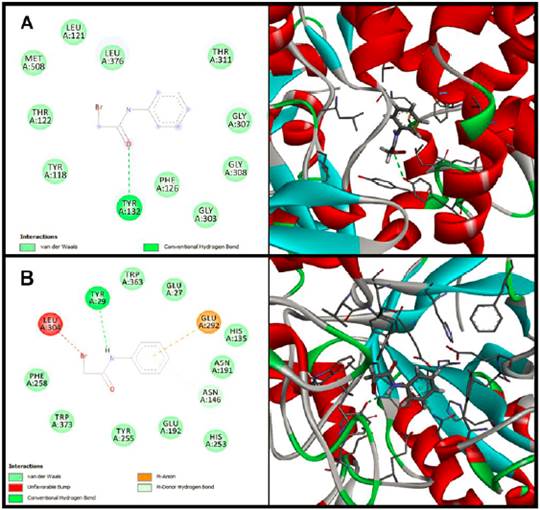
Figure 3 Interactions of 2-Bromo-N-phenylacetamide at the active enzymatic sites of the cell mem-brane (A) and cell wall (B) in Candida spp.
Thus, the results suggest that A1Br possibly acts by interfering in the fungal cell mem brane, since it presented binding energies favorable to the interaction with the enzyme, similar to those performed by the co-crystallized inhibitor [15,16]. However, in vitro studies are necessary to confirm this mechanism of action. The validation of molecular docking was performed through redocking, using the values of RMSD (Root Mean Standard Deviation) 0.95 Å (5TZ1) and 0.15 Å (1EQC) [11].
With the perspective of identifying a pharmacological tool that can be used in associa tion with fluconazole against resistant strains, the association test was performed with the seven resistant strains identified in the present study: 516, 587, 616, 700, 814, 917 and 439. The FICI indices ranged from 1.002 to 2.062, thus, the association between 2-Bromo-N-phenylacetamide and fluconazole was classified as indifferent for all stra ins [17,18]. It is important to emphasize that although the results of this association have been indifferent, the possibilities of association with other drugs should be investigated later, since they can bring interesting results for therapy [19,20].
CONCLUSION
In view of the above, it is possible to observe that 2-Bromo-N-phenylacetamide has a notorious antifungal activity, which had not yet been explored. In this way, this study sheds light on this compound and opens perspectives for its potential to be better elucidated, as it can become a promising drug candidate for application in clinical practice against invasive candidiasis, as well as against other fungal infections.














